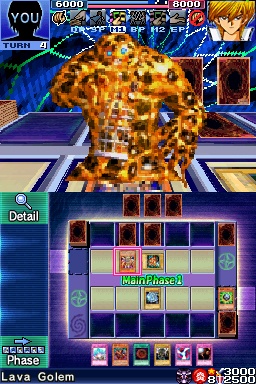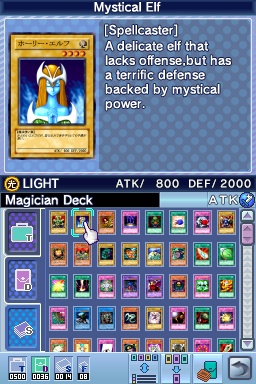Similar to the majority of the Yu-Gi-Oh! games that Konami has published over the past five years or so, Nightmare Troubadour for the Nintendo DS aims to accomplish the familiar goal of re-creating the real-world Yu-Gi-Oh! collectible card game. Nightmare Troubadour is marginally more successful than many of its predecessors to this end, thanks to an engaging tutorial system and the tactile advantage inherent to the Nintendo DS hardware.

Nightmare Troubadour doesn't waste a lot of time with setup, and within minutes of booting up the game you'll find yourself in the role of a young novice duelist prowling the town in search of other duelists to battle. There's competition all over the place, but you'll have to use your "duelist radar" to ferret them out, which requires you to drag a cursor around a city map with your stylus until the cursor starts "beeping" red. This would have a more immersive effect if the choice of your prospective opponents wasn't limited by your current experience level.
Once you've found a match, the game eases quickly into familiar Yu-Gi-Oh! territory. A quick ro-sham-bo game is played to determine who will take the first turn, and then you're brought to a standard Yu-Gi-Oh! card table. From here, the game is fundamentally no different from any of the other Yu-Gi-Oh! card games--each player, armed with a deck of monster, trap, and spell cards, tries to whittle their opponent's hit points down to zero. Mechanically, though, the game feels less abstract than it has in its prior console incarnations, due largely to this version's touch screen support. There's just something about using the stylus to physically tap the cards to activate them that makes the card game feel less simulated.
In the past, if you didn't know how to play the game, you either figured it out through trial and error, or, more likely, you simply didn't play at all. Nightmare Troubadour makes things much more inviting for the uninitiated with a small library of extremely helpful tutorials, which can be accessed at any time when you're not in an actual duel. These written tutorials cover everything from basic rules and terminology to more advanced strategies. Though the tutorials can be a little dense at times, they also can be incredibly helpful for first-timers. In addition to these non-interactive tutorials, there is a series of "puzzle" matches, where you're presented with a contrived scenario in which you'll have to use a specific strategy to complete successfully. Whether you're a beginner or not, these puzzle matches are a good way to hone your skills.
If playing against an artificial intelligent opponent isn't your thing, you can also go head-to-head with another player wirelessly, assuming the other player has his or her own copy of Nightmare Troubadour. The wireless two-player support is pretty standard, letting you stage matches and trade cards with other players.
At the end of both puzzle matches and regular duels, you're rewarded with points that can be spent on booster packs at the local card shop. You're immediately shown what cards you received in your booster pack upon purchase, but to actually use these new cards you'll have to go into the deck-editing system and add them to your live deck. The deck- editing system isn't as transparent as the actual card game, and there are a lot of options for how cards are displayed and sorted. It can take a while to figure out how to move cards between your live deck and your chest of reserve cards, let alone to make out what, exactly, it is that you're looking at.

The game's look, in general, isn't particularly striking, and it usually opts for functionality over visual panache. When you're in the overview of the city map, the lower screen looks like a typical municipal map, while the upper screen displays a simple painting that gives you a general feel for the neighborhood you're looking at. You'll see a decent-looking drawing of your opponent before you go into a match, but for the rest of the time you're just looking at a card table. The biggest effort to add some sparkle to the visuals comes in prerendered 3D versions of the card monsters, which appear in the upper screen. Frankly, these models don't look nearly as good as the card art that they're based on, and it doesn't help that their animations are limited to some choppy wiggling. The sound is equally pedestrian, cannibalizing nearly all of its menu sounds and innocuous background music from whatever centralized sound library Konami uses for all of its Yu-Gi-Oh! games.
In addition to Nightmare Troubadour's sensible use of the touch screen on the DS and its helpful tutorials, the biggest factor working in its favor is that Konami hasn't already churned out a half-dozen other Yu-Gi-Oh! games for the Nintendo DS…yet. But, even if Nightmare Troubadour weren't the only game in town, it would still be an acceptable choice for those just looking for some decent card battles for their DS.